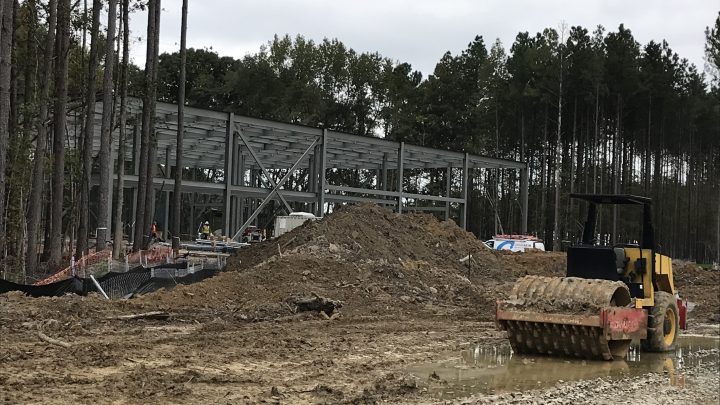
Federal pharma ingredient stockpile is under construction in Virginia
Federal pharma ingredient stockpile is under construction in Virginia

Some basic medications are in short supply in the United States. Part of the problem is that most of the ingredients for generic and over-the-counter drugs produced in the U.S. are imported, mainly from China and India. And those countries cut their exports during the pandemic. One possible solution? A new government stockpile of the ingredients used to make these medicines.
Drive almost three hours south of Washington, D.C., and you come to a winding back road in rural Petersburg, Virginia. Here, you’ll find the beginnings of the pharmaceutical ingredient stockpile — several construction sites set back in the woods. Standing near the project’s headquarters is Frank Gupton, one of the brains behind the operation.
Gupton heads Virginia Commonwealth University’s Medicines for All Institute, a group of chemists who work to make pharmaceutical manufacturing more efficient. They’re one of four contractors receiving federal funding to help create the stockpile. We walk over to a complex of hulking buildings behind barbed wire.
“So this is the manufacturing site where we’re going to be making the active pharmaceutical ingredients,” Gupton explained, pointing to a spot behind the barbed wire.
Two buildings are under construction here for the production of active pharmaceutical ingredients used to make generic drugs like antibiotics and sedatives. When the buildings are done and manufacturing starts, Gupton said some of the ingredients will be used right away to make drugs for hospitals, some could be sold to U.S. drug manufacturers, and some will end up in the government stockpile — stored in a warehouse being built down the road — to be used in an emergency like another pandemic.
“It’s very much modeled after the Strategic Petroleum Reserve,” Gupton told me.
That’s a big pool of crude oil that can be tapped if there’s a disruption in the energy market. Gupton said they’re a bit behind schedule but should get back on track to finish construction on the two buildings late next year or early in 2023. The delays, coincidentally, are from bottlenecks in the supply chain for construction materials.
“Concrete, steel — everything,” Gupton said. “And it’s not just affected the timeline, it’s affected the cost of the project.”
Any extra costs are the responsibility of the stockpile project partners under the terms of their $354 million contract with the Department of Health and Human Services.
Rena Conti has been keeping tabs on the stockpile project from her perch as a health economist at Boston University’s Questrom School of Business. She said there are strings attached to this government money.
“It’s not like there was a blank check written,” she explained. “It comes with responsibilities and benchmarks.”
Benchmarks like staying on schedule. The contract doesn’t appear to dictate what the stockpile partners can charge for any drug ingredients they decide to sell to U.S. drugmakers. The CEO of one of the partners, a company called Phlow, has been accused of overcharging in the past when he headed a different pharmaceutical company. Mariana Socal, who teaches U.S. pharmaceutical policy at Johns Hopkins University, wants some price transparency.
“We should be informed of what is the agreed upon price,” she said. “And that’s possible and feasible because we have seen this happen during the COVID-19 pandemic.” For example, when the federal government announced what it would pay for COVID vaccines.
Back at the construction site, Frank Gupton said some of the pharmaceutical ingredients could be sold to U.S. drugmakers. He wouldn’t say at what cost, but he thinks prices can be kept down through efficiency and automation. He said they can’t overcharge because then they won’t be able to compete with China and India. “So if we’re not competitive against global manufacturers, they won’t buy from us,” he said. “It’s pretty simple.”
Gupton said he and his partners will be transparent with the government about what it takes to make quality pharmaceutical ingredients. So it’ll be obvious if, say, China is selling pharmaceutical ingredients below cost, at a price no U.S. manufacturer could match.
There’s a lot happening in the world. Through it all, Marketplace is here for you.
You rely on Marketplace to break down the world’s events and tell you how it affects you in a fact-based, approachable way. We rely on your financial support to keep making that possible.
Your donation today powers the independent journalism that you rely on. For just $5/month, you can help sustain Marketplace so we can keep reporting on the things that matter to you.

















